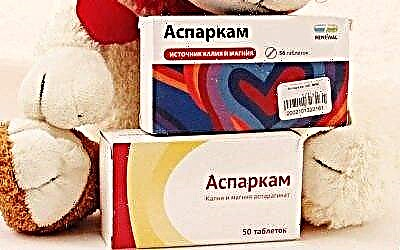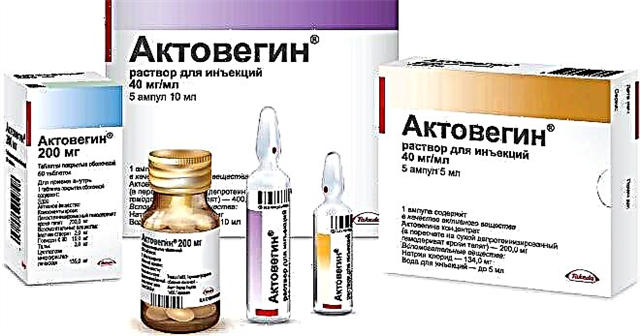
A medicine called Asparkam helps to eliminate the disorders caused by the lack of such important substances as magnesium and potassium. Such a drug is in great demand in the practice of cardiologists and is often prescribed to adults for the treatment of heart failure and arrhythmias. But in some cases, children are also prescribed it.

Release form and composition
"Asparkam" is produced by many pharmaceutical companies, which is sometimes reflected in the name of the drug ("Asparkam Avexima", "Asparkam-Farmak", etc.). Most manufacturers offer this medicine in tablet form. One pack usually contains 20 or 50 tablets, but there are packages with fewer or more of them. The drug is sold in blisters or polymer jars.
The tablets themselves are round, white, and have a risk. They are a source of two active ingredients at once - magnesium aspartate and potassium aspartate. The dosage of each of these compounds in one tablet is 175 mg, so it is written on the package "175 mg + 175 mg". Among the inactive substances of "Asparkam", depending on the manufacturer, there are talc, macrogol, calcium / magnesium stearate, povidone, corn starch and other components.

The drugs "Asparkam-Farmak" and "Asparkam-L" are available in injectable form. It is a clear solution poured into 5, 10 or 20 ml ampoules. It usually does not have any coloration and impurities, but a yellowish tint is the norm. This version of the drug is administered intravenously and also contains magnesium and potassium in the form of asparaginates.
Each milliliter of injectable Asparkam gives the patient 40 mg of magnesium asparaginate and 45.2 mg of potassium aspartate. In addition to these substances, the solution contains sterile water and sorbitol.

Operating principle
Potassium and magnesium salts present in both forms of the drug are of great value to the human body. Without a sufficient amount of them, it is impossible to contract the muscles and the course of metabolic processes in the heart muscle, and the function of many enzymes can also be disrupted. Since they are represented by asparaginates, this helps minerals to penetrate the cell membranes, which quickly makes up for the lack of such ions.
The presence of not only potassium, but also magnesium salts in Asparkam is due to the fact that the deficiency of these elements is quite often observed at the same time. In addition, the drug is in demand for various heart diseases, as it can reduce the toxic effects of cardiac drugs called glycosides. In this case, the therapeutic effect of such medicines under the influence of "Asparkam" does not decrease.

Indications
Most often, Asparkam is used in the treatment of heart rhythm disturbances, heart failure and other problems with the cardiovascular system. In addition, such a medicine is in demand when there is a lack of potassium and magnesium caused by various factors, for example, poor nutrition or absorption in the intestines.

Contraindications
"Asparkam" is prohibited in case of hypersensitivity to its constituents, as well as metabolic acidosis or dehydration. In addition, the drug should not be used in case of renal failure and high potassium content in the blood. In case of heart problems, the medication is not used if the ECG shows AV block.

Although the instructions for some tablets indicate the age of up to 18 years, the doctor can prescribe such a drug at any age, even newborns, if there is a reason for this.
Side effects
When using Asparkam, loose stools, thirst, discomfort in the stomach, vomiting and other ailments may appear. If these negative symptoms occur, you should immediately tell your doctor about them so that he prescribes another treatment.

Instructions for use
Asparkam tablets are taken after meals. The medicine is swallowed and washed down with water, and when used in babies (for example, in infants), it is permissible to divide it into parts, then grind it into powder and give it diluted with water, like a suspension.


Injection "Asparkam" is injected into a vein either in a stream or through a dropper after mixing with glucose or other solution for infusion.
The dosage and regimen of taking the drug for each child is determined by the doctor, because it is influenced by the disease, and the age of the baby, and some other factors.
If "Asparkam" was discharged for some pathology, it is used in one dose, and for prophylaxis it should be given in completely different dosages.
The duration of treatment with "Asparkam" is also influenced by the condition of the child and his diagnosis. The tool can be used in small courses of 3-4 weeks, and for a longer time.


Overdose
Exceeding the dosage of Asparkam can lead to bradycardia, muscle weakness, decreased blood pressure, paresthesia, fatigue, urge to vomit and other symptoms that occur with an excessively high concentration of potassium or magnesium ions in the blood. To eliminate them, calcium chloride and symptomatic agents are used.
Drug interactions
With "Diakarb"
"Asparkam" is often used in combination with "Diacarb" to eliminate the side effect of this diuretic (lowering the level of potassium in the blood). This combination of drugs is in demand in neurology and is prescribed for the treatment of hydrocephalus, epilepsy, edema, increased intracranial pressure, glaucoma or concussion.

Incompatibility
With regard to incompatibility, treatment with "Asparkam" should not be combined with the use of astringents, drugs for anesthesia, beta-blockers, non-steroidal pain medications and some other medications. All groups of drugs, the use of which may affect the action of "Asparkam" and the patient's condition, are indicated in the annotation.
Terms of sale and storage
Tablet "Asparkam" is an over-the-counter medication, and an injectable drug can only be purchased on a doctor's prescription. The price of the medication depends on the manufacturer, but is not high. For a package of 50-56 tablets you need to pay about 40-60 rubles, and 10 ampoules of "Asparkam-L" 5 ml each cost about 50 rubles.
Store both forms of medication at home in a dry place. The recommended storage temperature is 10-25 degrees. The shelf life of the solution for injections is 2 years, and the shelf life of tablets is 3 years (sometimes 4).

Reviews
On the treatment with "Asparkam" you can find mostly positive reviews. Doctors consider it an effective drug for a lack of potassium or magnesium, and also note its beneficial effect in heart disease. Parents confirm that this medication helped get rid of seizures, tachycardia and arrhythmias, which led to an improvement in the heart and well-being of the child.
Among the disadvantages of the drug are the presence of contraindications and the dosage form that is inconvenient for children (there are no syrups and suspensions). At the same time, the tolerability of the drug is assessed as good, since side effects are rare. Affordable price and availability in most pharmacies are also attributed to the advantages of "Asparkam".
Analogs
The most popular analogue of Asparkam can be called Panangin, because such a drug also contains magnesium and potassium asparaginates, is produced in the same forms and is used for the same indications, but it costs a little more. Instead, the doctor may also prescribe other drugs, taking into account the reason for the appointment of "Asparkam", for example, multivitamins, which contain a sufficient dose of potassium and magnesium.

For more information about Asparkam, see the next video.



